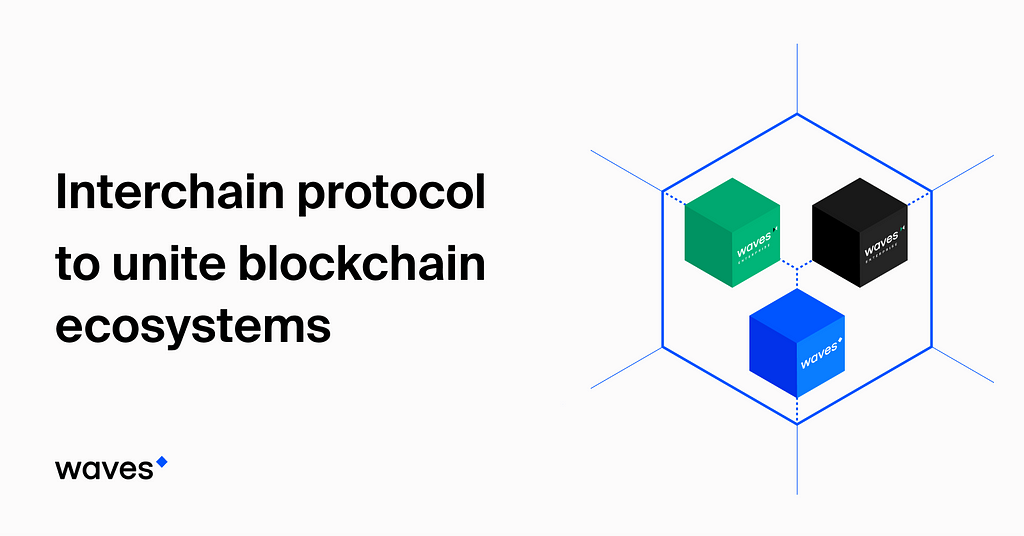
We are introducing a new vision to unify the technologies of the Waves ecosystem.
A while ago we announced a new stage in the development of the Waves ecosystem.
The idea was to combine all the advantages of our public and private blockchains, while at the same time supporting high transaction speeds. While working on the Waves 2.0 white paper we realized that it made sense to describe our general approach to the development of the next generation of the Waves ecosystem first. A series of white papers on specific parts of the whole Waves Chains ecosystem is underway.
Here’s what the ecosystem will look like:

Interchain protocol
We are developing a special protocol that will bring blockchain interoperability to the Waves ecosystem. Initially, this protocol will simply connect blockchains within the Waves ecosystem itself. Later, it will be enhanced to enable interaction between Waves and the Ethereum blockchain, with its numerous native projects. We are confident that the implementation and integration of such a protocol will help not only the Waves ecosystem, but also the industry as a whole. After solving the problem of interoperability, we will be much closer to the widespread use of blockchain technology and its implementation for socially important applications.
Public blockchain scalability
We already have a public blockchain on the Waves Platform that works well. As the number of users grows, greater scalability will be required. Sidechains provide some degree of scalability, but this will not be enough. We will therefore develop and implement sharding approaches into the main Waves network to further increase network performance and scale. Network interoperability combined with the scaling of individual networks is the optimal path for getting the best out of distributed ledger technology.
Born to be a DeFi platform
Waves Platform is already very well suited to the implementation of DeFi projects. There is no denying that finance is the best use case for blockchain technology. And most existing decentralized applications are, to one degree or another, financial in nature. There is no need or reason to resist this reality. Therefore, our public blockchain will be focusing on DeFi applications. Waves has excellent characteristics for this:
– Fast transactions
– Low fees
– No gas
– Built-in DEX
To this end, we have worked hard to create some outstanding tools for developers:
– The Ride language, which was specifically designed for easy development and execution in decentralized environments. Ride is a concise, human-readable language that is powerful but non-Turing complete. Its key features (including lazy execution and a modern typed functional approach, plus flat fees and no gas) avoid the vulnerabilities of other smart contract languages and ensure reliable execution with a zero failure rate.
– IDE. Waves is very developer-friendly, with an IDE for learning and sandbox development, and a Visual Studio Code plugin for advanced users.
– Technical support. We provide technical support for developers and help for learning the Ride language. Here is our Web3 coding course: https://stepik.org/course/54415/promo
In short, it’s the ideal choice for DeFi applications.
Service Chains
Another important building block of Waves Chains is so-called Service chains. These serve a particular purpose, providing specific functionality for the chains interacting with them.
An existing example of such a network is our current Waves Enterprise network, which is already used by a number of corporate projects.
Additionally, we plan to create Oracle chains that will provide real-world data to blockchains, so our clients can use this information for whatever applications they wish. Some of the oracles we intend to connect in the future include:
– Data oracles that will provide information on key markets (stocks, bonds, currencies, commodities), weather conditions, traffic volumes and events, population data, and so on.
– Notary oracles that will provide notarized data or official information from state registers necessary for the work of certain corporate clients.
– Bridge-chains connecting Waves Ecosystem to external projects such as Ethereum.
– Bridge-chains connecting Waves Ecosystem to external projects such as Ethereum.
Custom Chains
This is our term for the many bespoke private chains that are created using Waves Enterprise technologies for corporate clients. These custom chains are essentially sub-chains (sidechains) that anchor into the Waves Enterprise Chain. Our partners can deploy as many custom chains as they want for each project and broadcast their encrypted private data to the Service Chain to ensure its safety and immutability.
On top of that, custom chains will exist in an open setting as well. We plan to unify the development of public and private custom chains so that there’s a shared codebase and potential interoperability.
A future worth working for
All of these chains will be tied together by our Interchain protocol, connecting them to external chains as well. The scalable and robust Waves mainchain is going to be the pillar of the whole ecosystem, with connecting chains (both public and private) having access to all the ecosystem’s instruments.
In the coming weeks, we’ll be publishing a series of blog posts detailing further aspects of this ecosystem — including the Interchain protocol, Sharding, DeFi, and our Oracles chains.
Read Waves News channel
Follow Waves Twitter
Watch Waves Youtube
Subscribe to Waves Subreddit
Ecosystem development strategy: Waves Chains was originally published in Waves Platform on Medium, where people are continuing the conversation by highlighting and responding to this story.
